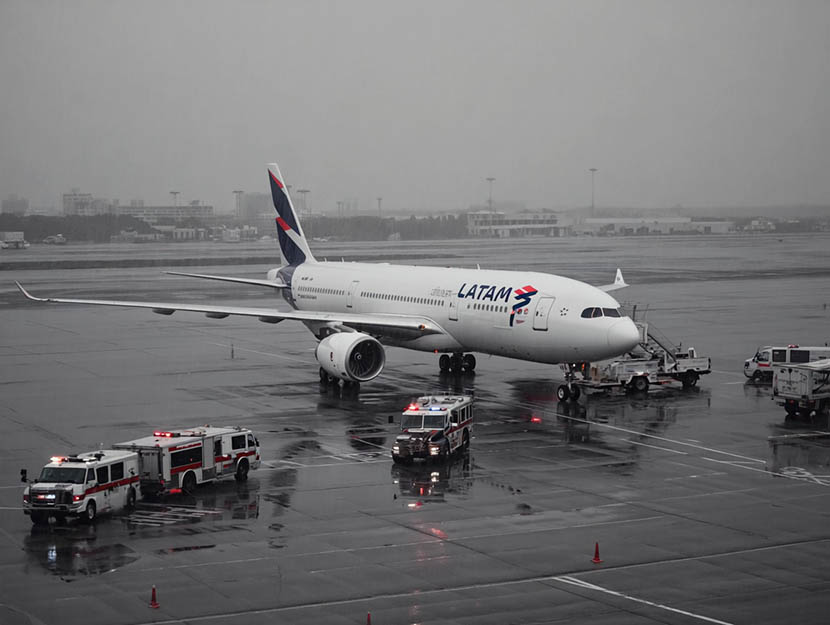Santiago Bound LATAM Airlines Boeing Dreamliner Makes Emergency Landing at Los Angeles International Airport


A Santiago-bound LATAM Airlines Boeing Dreamliner made an emergency landing at Los Angeles International Airport, sparking fresh concern among global travelers and aviation watchers. The incident unfolded rapidly when LATAM Airlines flight LA603, en route from Los Angeles to Santiago, had to abort its transcontinental journey and return to base after a critical electrical failure. As a result, the Boeing Dreamliner activated its Ram Air Turbine (RAT)—a rare but serious indication of a systems malfunction in flight.
The emergency landing at Los Angeles International Airport occurred after the crew reported a RAT deployment shortly after takeoff. Pilots immediately alerted air traffic control and followed standard emergency protocols. They requested a return to Los Angeles and performed a mid-air fuel dump to reduce landing weight. The Boeing Dreamliner then touched down safely on runway 25L, ending a tense 87-minute flight that never left California skies.
This Santiago-bound flight incident involving LATAM Airlines raises critical questions about the reliability of the Boeing Dreamliner fleet and the risks passengers face—even on some of the world’s most advanced aircraft. While the LATAM Airlines crew is being praised for their swift action, this high-stakes drama at Los Angeles International Airport adds to the growing list of in-flight emergencies reported this year.
As aviation safety stays under global scrutiny, this emergency landing story is more than a technical glitch—it’s a reminder of how every journey, even aboard a Dreamliner, can turn uncertain in seconds.
A Boeing 787 emergency landing in Los Angeles has raised fresh concerns over aviation safety. A LATAM Airlines Dreamliner turned back mid-flight after a critical electrical issue led to the deployment of the Ram Air Turbine (RAT). The plane landed safely. But many are now asking what went wrong—and what this means for travelers.
Emergency Declared After RAT Deployment
A LATAM Boeing 787-8 operating flight LA603 from Los Angeles to Santiago, Chile, declared an emergency shortly after takeoff. The aircraft had just departed from runway 25R at LAX and was climbing to FL230 when the cockpit reported a serious technical issue. In radio communication, the pilot announced, “We have Romeo Alpha Tango allotted,” a phrase indicating the deployment of the Ram Air Turbine (RAT). This emergency tool only activates when both main electrical systems fail, making the situation highly critical.
What Is the Ram Air Turbine and Why It Matters
The Ram Air Turbine (RAT) is a last-resort device. It generates power using airflow, especially when all main electrical and hydraulic systems go offline. Its use indicates a possible dual electrical failure. In most commercial flights, this system never activates. For LATAM flight LA603, its deployment points to a major power system disruption just minutes into the journey. It is rare for this turbine to be used, and when it is, it usually prompts an emergency return, as it did here.
LATAM Crew Responds With Calm and Precision
Despite the technical emergency, the LATAM crew followed all protocol. After the RAT deployed, the pilots immediately requested to return to Los Angeles. According to radar and ATC logs, they performed a fuel dump—a standard safety procedure—before initiating descent. The aircraft safely landed on runway 25L at LAX, approximately 1 hour and 27 minutes after takeoff. It then taxied to the gate on its own power, without requiring towing or emergency vehicles.
Passenger Experience: Calm But Alert
There have been no confirmed passenger reports of panic or injuries. However, the incident likely created tension on board. With the RAT deployed and the aircraft forced to return, it’s expected that passengers were notified of the emergency. According to industry experts, the flight crew’s ability to manage the return without further escalation speaks to the professionalism of LATAM’s operational standards.
Rising Spotlight on Boeing 787 Incidents
This is not the first time a Boeing 787 Dreamliner has made headlines. Over the past few years, the 787 has seen several technical incidents, ranging from electrical malfunctions to engine software errors. While Boeing maintains that the Dreamliner is one of the most advanced jets in operation today, such events keep fueling concerns. The RAT deployment in this case underscores potential weaknesses in either design or system durability that merit a close review by aviation regulators.
What This Means for LATAM Airlines and Travelers
For LATAM Airlines, this emergency may prompt internal technical reviews, possible fleet checks, and regulatory scrutiny. Passengers booked on upcoming Dreamliner flights with LATAM may experience delays or aircraft changes. Travel agents and frequent flyers may also seek reassurances about aircraft maintenance and contingency plans. In the highly competitive South American airline market, safety perception can make or break trust.
Los Angeles Airport’s Role and Efficiency
LAX Airport, one of the busiest hubs in North America, once again demonstrated its efficiency in handling mid-air emergencies. With rapid coordination between air traffic control, fire and rescue, and ground staff, the situation was managed smoothly. This event highlighted why LAX remains a top choice for global carriers, despite the high volume of daily movements.
Could This Affect Other Boeing Flights?
Boeing will likely review the data from this incident closely. While LATAM operates the aircraft, Boeing remains responsible for long-term airworthiness and design integrity. Airlines worldwide that use the 787 model may conduct precautionary system checks. Travel industry analysts anticipate updates to safety advisories or pilot checklists. Although isolated, events like this can ripple across the industry—especially if they raise questions about equipment reliability.
Social Media Buzz: Safety vs. Panic
The incident quickly spread across aviation forums and social media. Many passengers and observers praised the LATAM crew’s calm execution. Others expressed concern that another Boeing 787 had faced a major issue. Travel influencers and frequent flyers called for more transparency on aircraft readiness. In an era where news travels fast, how airlines handle these updates can shape brand reputation overnight.
Should Travelers Be Worried?
While emergency landings are serious, they are also proof that aviation safety systems work. The RAT deployed, the crew followed the correct protocols, and the aircraft landed safely. No passengers were harmed. In fact, most aviation professionals would say this outcome is ideal under the circumstances. Still, passengers should stay informed. Ask airlines about aircraft types, and do not hesitate to raise questions about maintenance and safety.
LATAM’s Track Record and Safety History
LATAM Airlines, one of South America’s largest carriers, generally enjoys a good safety record. Its fleet includes a mix of Boeing and Airbus aircraft. Past incidents have been rare and well-handled. However, each new event adds pressure to maintain and reinforce trust. It remains to be seen if LATAM will issue a formal statement or compensation offer to affected passengers on LA603.
What Happens Next for the Aircraft?
The Boeing 787 involved in the emergency (registration CC-BBI) will likely be grounded for inspection. Engineers will examine data logs, electrical systems, and RAT deployment diagnostics. Until the cause is confirmed and resolved, this aircraft will not return to service. Aviation authorities may also open an investigation, particularly if initial findings suggest design or component fault.
Travel Insurance and Refunds: What Passengers Should Know
Passengers of flight LA603 are entitled to a rebooking or refund, depending on LATAM’s policy and Chilean/US aviation law. Those who purchased travel insurance should review clauses covering delays, cancellations, or in-flight emergencies. Events like this highlight why travel protection is more important than ever, especially on long-haul international routes.
Aviation Experts Call for RAT Protocol Review
A growing number of aviation safety consultants now recommend updated training and simulation protocols for Ram Air Turbine deployment. Since most pilots may only experience this in simulators, incidents like LA603 are real-world tests of emergency response. Some experts also argue that airline SOPs (Standard Operating Procedures) should more clearly communicate with passengers in such emergencies to avoid fear and confusion.
Final Thoughts: Safety Systems Work, But Questions Remain
This emergency has one silver lining—it shows that systems like the RAT do what they’re supposed to. The flight landed safely. No injuries occurred. Still, frequent travelers, airline partners, and aviation professionals are right to demand answers. Was this a fluke or part of a bigger pattern in the 787 family? Only further investigation will tell. For now, one thing is clear: in aviation, vigilance never takes off.
The post Santiago Bound LATAM Airlines Boeing Dreamliner Makes Emergency Landing at Los Angeles International Airport appeared first on Travel And Tour World.






